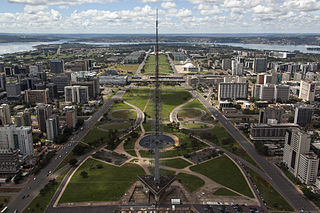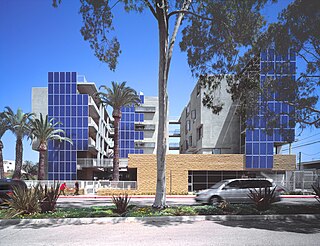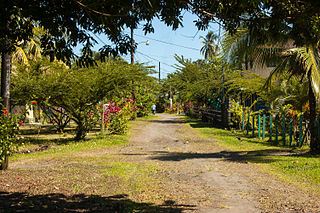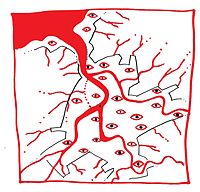
An ecovillage is a traditional or intentional community with the goal of becoming more socially, culturally, economically, and/or ecologically sustainable. An ecovillage strives to produce the least possible negative impact on the natural environment through intentional physical design and resident behavior choices. It is consciously designed through locally owned, participatory processes to regenerate and restore its social and natural environments. Most range from a population of 50 to 250 individuals, although some are smaller, and traditional ecovillages are often much larger. Larger ecovillages often exist as networks of smaller sub-communities. Some ecovillages have grown through like-minded individuals, families, or other small groups—who are not members, at least at the outset—settling on the ecovillage's periphery and participating de facto in the community.

Urban design is an approach to the design of buildings and the spaces between them that focuses on specific design processes and outcomes. In addition to designing and shaping the physical features of towns, cities, and regional spaces, urban design considers 'bigger picture' issues of economic, social and environmental value and social design. The scope of a project can range from a local street or public space to an entire city and surrounding areas. Urban designers connect the fields of architecture, landscape architecture and urban planning to better organize physical space and community environments.
Sustainable living describes a lifestyle that attempts to reduce the use of Earth's natural resources by an individual or society. It is referred to as "zero wastage living" or "net zero living". Its practitioners often attempt to reduce their ecological footprint by altering their home designs and methods of transportation, energy consumption and diet. Its proponents aim to conduct their lives in ways that are consistent with sustainability, naturally balanced, and respectful of humanity's symbiotic relationship with the Earth's natural ecology. The practice and general philosophy of ecological living closely follows the overall principles of sustainable development.

Urban renewal is a program of land redevelopment often used to address urban decay in cities. Urban renewal involves the clearing out of blighted areas in inner cities to clear out slums and create opportunities for higher class housing, businesses, and other developments.

Jaime Lerner was a Brazilian politician. He was the governor of the state of Paraná, in southern Brazil. He is renowned as an architect and urban planner, having been mayor of Curitiba, capital of Paraná, three times. In 1994, Lerner was elected governor of Paraná, and was re-elected in 1998.
Marjetica Potrč is an artist and architect based in Ljubljana, Slovenia. Potrč's interdisciplinary practice includes on-site projects, research, architectural case studies, and series of drawings. Her work documents and interprets contemporary architectural practices and the ways people live together.
An eco-city or ecocity is "a human settlement modeled on the self-sustaining resilient structure and function of natural ecosystems", as defined by Ecocity Builders. Simply put, an eco-city is an ecologically healthy city. The World Bank defines eco-cities as "cities that enhance the well-being of citizens and society through integrated urban planning and management that harness the benefits of ecological systems and protect and nurture these assets for future generations". Although there is no universally accepted definition of an 'eco-city', among available definitions, there is some consensus on the basic features of an eco-city.

Microgeneration is the small-scale production of heat or electric power from a "low carbon source," as an alternative or supplement to traditional centralized grid-connected power.

Sustainable landscape architecture is a category of sustainable design concerned with the planning and design of the built and natural environments.

Marco Casagrande is a Finnish architect, environmental artist, architectural theorist, former mercenary, writer and professor of architecture. He graduated from Helsinki University of Technology department of architecture (2001).

Treasure Hill is a community in Taipei, Taiwan. Originally an illegal settlement, it was founded by the Kuomintang military veterans at the end of the 1940s and served originally as an anti-aircraft position.

Hsieh Ying-chun is a Taiwanese architect and contractor.

Colorado Court Housing is a 44-unit housing project designed by the architectural firm Pugh + Scarpa. Colorado Court is the first United States Green Building Council (USGBC) "LEED" certified multi-family housing project, achieving "Gold" certification. Located at the corner of a main offramp of the Santa Monica freeway, Colorado Court's highly visible position makes it gateway to the city of Santa Monica, California. The 44-unit, five-story building is the first affordable-housing project the United States to be LEED certified and is nearly 100% energy neutral (Colorado Court Movie Clip). This project is an excellent model of sustainable development in an urban environment, provides a model for private/public partnerships benefit the community, and promotes diversity in an urban environment through strategically placed affordable housing.

Roan Ching-Yueh is a Taiwanese architect, writer, curator and a Professor of Department of Art and Design, Yuan Ze University.

Micro-sustainability is the portion of sustainability centered around small scale environmental measures that ultimately affect the environment through a larger cumulative impact. Micro-sustainability centers on individual efforts, behavior modification, education and creating attitudinal changes, which result in an environmentally conscious individual. Micro-sustainability encourages sustainable changes through "change agents"—individuals who foster positive environmental action locally and inside their sphere of influence. Examples of micro-sustainability include recycling, power saving by turning off unused lights, programming thermostats for efficient use of energy, reducing water usage, changing commuting habits to use less fossil fuels or modifying buying habits to reduce consumption and waste. The emphasis of micro-sustainability is on an individual's actions, rather than organizational or institutional practices at the systemic level. These small local level actions have immediate community benefits if undertaken on a widespread scale and if imitated, they can have a cumulative broad impact.
Ecological urbanism draws from ecology to inspire an urbanism that is more socially inclusive and sensitive to the environment. It is less ideologically driven, than green urbanism or sustainable urbanism. In many ways, ecological urbanism is an evolution of, and a critique of, Landscape Urbanism arguing for a more holistic approach to the design and management of cities. This type of urbanism has a central scope four main objectives, compactness, complexity, efficiency and stability. This model of Urbanism has as a goal to tackle the current challenges of society by intertwining sustainability and urban occupation models. The term appeared first in 1998 as "EcoUrbanism" in a book by Architect and Planner Miguel Ruano, who defined it as "the development of multi-dimensional sustainable human communities within harmonious and balanced built environments". The term was used later in April 2003 at a conference at the University of Oregon, and again in 2006 in a paper by Jeffrey Hou. The phrase was used by Mohsen Mostafavi in 2007 in Intervention Architecture and in a lecture at the Canadian Centre for Architecture, ecological urbanism as a project was largely started at Harvard University Graduate School of Design, with a conference, and exhibition, and book.

Ruin Academy is an independent cross-over architectural research center in the Urban Core area of Taipei City, Taiwan. It is 'set to re-think the industrial city and the modern man in the box' through research and a series of workshops.

Green urbanism has been defined as the practice of creating communities beneficial to humans and the environment. According to Timothy Beatley, it is an attempt to shape more sustainable places, communities and lifestyles, and consume less of the world's resources. Urban areas are able to lay the groundwork of how environmentally integrated and sustainable city planning can both provide and improve environmental benefits on the local, national, and international levels. Green urbanism is interdisciplinary, combining the collaboration of landscape architects, engineers, urban planners, ecologists, transport planners, physicists, psychologists, sociologists, economists and other specialists in addition to architects and urban designers.

McCormack Baron Salazar is an American real estate development firm based in St. Louis, Missouri specializing in economically integrated urban neighborhoods with more than $4.23 billion invested in affordable and mixed-income housing projects. McCormack Baron Salazar provides development as well as ongoing property management services, development financing and tax credit services, and asset management services. </ref>

Urban planning, also known as town planning, city planning, regional planning, or rural planning, is a technical and political process that is focused on the development and design of land use and the built environment, including air, water, and the infrastructure passing into and out of urban areas, such as transportation, communications, and distribution networks and their accessibility. Traditionally, urban planning followed a top-down approach in master planning the physical layout of human settlements. The primary concern was the public welfare, which included considerations of efficiency, sanitation, protection and use of the environment, as well as effects of the master plans on the social and economic activities. Over time, urban planning has adopted a focus on the social and environmental bottom-lines that focus on planning as a tool to improve the health and well-being of people while maintaining sustainability standards. Sustainable development was added as one of the main goals of all planning endeavors in the late 20th century when the detrimental economic and the environmental impacts of the previous models of planning had become apparent. Similarly, in the early 21st century, Jane Jacob's writings on legal and political perspectives to emphasize the interests of residents, businesses and communities effectively influenced urban planners to take into broader consideration of resident experiences and needs while planning.


















